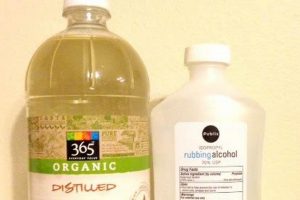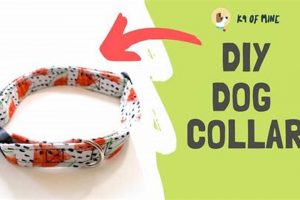The creation of dental cleaning agents for canines using household ingredients is a growing trend among pet owners. These formulations are designed to promote oral hygiene in dogs, often providing a cost-effective alternative to commercially available products. Examples range from simple baking soda and water mixtures to more complex recipes including coconut oil and broth.
Maintaining proper dental hygiene in dogs is crucial for their overall health and well-being. Poor oral health can lead to periodontal disease, which has been linked to systemic conditions affecting the heart, liver, and kidneys. Historically, dental care for dogs has been overlooked, leading to increased veterinary interventions. The rise of accessible online information and a focus on holistic pet care has driven the interest in home-prepared dental solutions.
Understanding the constituents and application methods of these preparations is paramount. The subsequent discussion will focus on appropriate ingredients, safety considerations, and effective application techniques for promoting canine dental health at home.
DIY Dog Toothpaste
Effective canine dental hygiene hinges on several critical factors. The following guidelines offer practical advice for safely and effectively implementing homemade dental care solutions for dogs.
Tip 1: Ingredient Selection is Paramount: Employ only canine-safe ingredients. Xylitol, a common sweetener, is highly toxic to dogs and must be strictly avoided. Research each ingredient thoroughly before inclusion in any dental formula.
Tip 2: Baking Soda Requires Moderation: While mildly abrasive, baking soda can disrupt a dog’s natural oral pH if used excessively. Limit its concentration to a small percentage of the overall mixture.
Tip 3: Coconut Oil Offers Benefits: Unrefined coconut oil possesses antibacterial properties and can aid in plaque removal. Its pleasant taste may also increase canine acceptance of the cleaning process.
Tip 4: Broth Enhances Palatability: Low-sodium chicken or beef broth can be added in small quantities to improve the taste of homemade formulas. Ensure the broth contains no onion or garlic powder, both of which are toxic to dogs.
Tip 5: Gradual Introduction is Key: Allow the dog to acclimate to the taste and texture of the dental solution. Begin by offering a small amount on a finger and gradually progress to using a soft-bristled toothbrush.
Tip 6: Supervise During Brushing: Closely monitor the dog during the brushing process to prevent excessive ingestion of the dental solution. Ingestion in small quantities is generally harmless, but large amounts may cause digestive upset.
Tip 7: Regular Veterinary Check-ups are Non-Negotiable: Homemade solutions should complement, not replace, professional dental cleanings. Schedule regular veterinary check-ups to assess the dog’s oral health and address any underlying issues.
Adhering to these guidelines enhances the likelihood of successful implementation and promotes optimal oral hygiene in canines. However, professional veterinary advice remains essential for comprehensive dental care.
The subsequent section will address potential risks and drawbacks associated with these home-prepared dental solutions, emphasizing the importance of informed decision-making.
1. Ingredient safety crucial
The phrase “Ingredient safety crucial” underscores the paramount importance of selecting appropriate and non-toxic components when formulating homemade dental cleaning agents for canines. This emphasis arises from the potential for serious adverse health effects should a dog ingest harmful substances commonly found in human-grade products but detrimental to canine physiology.
- Xylitol Toxicity
Xylitol, a sugar alcohol sweetener frequently used in sugar-free gums and candies, is highly toxic to dogs. Even small amounts can cause a rapid release of insulin, leading to hypoglycemia (low blood sugar) and potentially liver failure. Its presence in a homemade formula, even in trace amounts, poses a significant threat.
- Essential Oil Concerns
While certain essential oils may offer antimicrobial properties, many are toxic to dogs, even when diluted. Oils such as tea tree, pennyroyal, and wintergreen can cause neurological damage, liver damage, or respiratory distress if ingested or absorbed through the skin. Strict adherence to veterinarian-approved safe oils and dilutions is necessary.
- Allergic Reactions
Dogs can develop allergic reactions to various ingredients, including those commonly used in “diy dog toothpaste” recipes. Common allergens include certain food-grade dyes, preservatives, and even natural ingredients. Monitoring the dog for signs of allergic reaction, such as skin irritation, swelling, or difficulty breathing, is essential when introducing a new formula.
- Digestive Sensitivity
Certain ingredients, while not inherently toxic, can cause digestive upset in dogs. Excessive amounts of baking soda, for example, can disrupt the oral pH balance and lead to vomiting or diarrhea. Thorough research on each ingredient’s potential effects on canine digestion is a prerequisite to formulation.
These facets highlight the critical need for informed decision-making when considering home-prepared dental solutions for dogs. The potential risks associated with improper ingredient selection far outweigh the perceived benefits of a “diy” approach. Consulting with a veterinarian or veterinary dentist remains the safest course of action to ensure the selected ingredients are suitable for the individual dog’s health status and needs.
2. Baking soda caution
The incorporation of baking soda into homemade canine dental cleaning agents necessitates careful consideration due to its potential effects on a dog’s oral environment and overall health. While often included for its mild abrasive properties, improper usage can lead to adverse consequences.
- Oral pH Imbalance
Baking soda, being alkaline, can disrupt the natural pH balance within a dog’s mouth if used in excessive quantities or frequency. This imbalance can inhibit the growth of beneficial oral bacteria and create an environment more conducive to the proliferation of harmful bacteria. For example, prolonged alkaline exposure can exacerbate existing periodontal issues.
- Enamel Erosion
Despite its mild abrasive nature, excessive or vigorous application of baking soda can contribute to the erosion of tooth enamel. Canine enamel is thinner than human enamel, making it more susceptible to damage from abrasive substances. Continued enamel erosion can lead to increased tooth sensitivity and vulnerability to decay. Commercial toothpastes formulated for dogs often contain abrasives with particle sizes and concentrations specifically designed to minimize this risk.
- Sodium Ingestion Concerns
Baking soda contains sodium, and excessive ingestion can be problematic for dogs with certain underlying health conditions, such as kidney disease or heart failure. These conditions often require a low-sodium diet to manage fluid retention and blood pressure. Overconsumption of baking soda through “diy dog toothpaste” could compromise these dietary restrictions and exacerbate the dog’s health issues. Carefully controlled quantities and infrequent application are essential to mitigate this risk.
- Irritation and Sensitivity
Some dogs may exhibit sensitivity or irritation to baking soda, manifesting as redness, inflammation, or discomfort in the gums and oral tissues. Such reactions necessitate immediate discontinuation of the product. Hypoallergenic alternatives should be considered under veterinary guidance. It is prudent to conduct a patch test on a small area of the dog’s gums before full application to assess sensitivity.
In conclusion, while baking soda may offer some benefits in homemade canine dental solutions, its use demands moderation and careful monitoring. Overuse presents several risks, including oral pH imbalance, enamel erosion, sodium ingestion, and potential irritation. A veterinarian’s advice should be sought to determine the suitability of baking soda in a particular dog’s dental care regimen and to establish safe application parameters. Alternative abrasive agents or enzyme-based dental products may offer a safer and more effective approach for maintaining canine oral hygiene.
3. Coconut oil benefits
The inclusion of coconut oil in homemade canine dental formulations stems from its purported beneficial properties for oral health. These benefits, while not definitively proven through rigorous clinical trials in dogs, are often extrapolated from human studies and anecdotal evidence, warranting a careful and informed evaluation.
- Antimicrobial Action
Coconut oil contains medium-chain triglycerides, primarily lauric acid, which exhibit antimicrobial activity. Lauric acid can disrupt the cell membranes of certain bacteria and viruses, potentially reducing the oral microbial load. In vitro studies have demonstrated lauric acid’s efficacy against Streptococcus mutans, a bacterium implicated in dental caries. Its application in “diy dog toothpaste” aims to control pathogenic bacteria, thereby reducing plaque formation and gingivitis risk.
- Plaque Reduction Potential
Some proponents suggest that coconut oil can help loosen and remove plaque through a process of emulsification. The oil’s viscosity may facilitate mechanical removal of debris and superficial plaque deposits during brushing. However, the efficacy of coconut oil in plaque removal compared to established mechanical or chemical dental cleaning methods requires further investigation in canine subjects. Evidence supporting substantial plaque reduction in dogs solely through coconut oil application remains limited.
- Improved Palatability
The mild flavor and aroma of coconut oil can enhance the palatability of homemade dental preparations, potentially increasing canine acceptance and compliance with oral hygiene routines. This is particularly relevant for dogs that are resistant to traditional brushing methods or commercial toothpastes. The addition of a palatable ingredient can make the brushing experience more positive, thereby improving the consistency of dental care.
- Moisturizing Effect
Coconut oil possesses moisturizing properties that can help maintain the hydration of the oral mucosa. This is particularly beneficial for dogs with dry mouth (xerostomia) or those prone to gum irritation. By lubricating the oral tissues, coconut oil can reduce friction and discomfort during brushing, potentially promoting better oral hygiene practices.
The purported benefits of coconut oil in “diy dog toothpaste” are multifaceted, encompassing antimicrobial action, plaque reduction potential, improved palatability, and moisturizing effects. While these attributes may contribute to improved oral hygiene, they should not be considered a replacement for professional veterinary dental care. The efficacy of coconut oil in maintaining optimal canine dental health requires further scientific validation through controlled clinical studies. Its use should be approached cautiously, with consideration for individual canine needs and potential sensitivities.
4. Veterinary consultation essential
The phrase “Veterinary consultation essential” underscores a critical safeguard when considering the use of homemade dental preparations for canines. The practice of creating “diy dog toothpaste” introduces variables and potential risks absent in commercially formulated and veterinarian-approved dental products. A consultation with a qualified veterinarian provides the necessary expertise to navigate these risks and ensure the chosen ingredients and application methods are appropriate for the individual animal.
The absence of veterinary guidance can lead to several detrimental outcomes. An owner, lacking professional knowledge, might select ingredients that are toxic or allergenic to the specific dog. Pre-existing oral health conditions, such as periodontal disease, may be masked or exacerbated by inappropriate home care, delaying necessary professional intervention. For instance, a dog with sensitive gums might experience increased pain and inflammation from a “diy dog toothpaste” containing abrasive elements, while an underlying infection remains untreated. Similarly, certain medical conditions necessitate specific considerations; a dog with kidney disease requires careful sodium management, a factor often overlooked in homemade recipes. The veterinarian can assess the dog’s overall health, identify potential risks, and recommend tailored dental care strategies.
In summary, veterinary consultation is not merely advisable but a prerequisite for responsible canine dental care involving homemade solutions. It serves to prevent harm, ensure appropriate ingredient selection, and address underlying health concerns that might be overlooked by a layperson. Ultimately, prioritizing professional veterinary guidance safeguards the dog’s oral and systemic well-being, ensuring that “diy dog toothpaste” endeavors are conducted safely and effectively as part of a comprehensive dental health plan.
5. Supervision needed
The necessity of supervision during canine dental hygiene practices, particularly when employing “diy dog toothpaste” formulations, arises from inherent risks associated with ingredient ingestion, behavioral responses, and potential allergic reactions. Attentive observation mitigates these risks and ensures the safety and efficacy of the dental cleaning process.
- Prevention of Excessive Ingestion
Unlike commercially formulated canine toothpastes, homemade varieties may not always be palatable or formulated for safe ingestion. While small amounts of some ingredients may be harmless, excessive consumption can lead to gastrointestinal upset, electrolyte imbalances, or even toxicity depending on the ingredients used. Supervision allows for immediate intervention if a dog attempts to consume a large quantity of the “diy dog toothpaste,” preventing potential health complications. For example, a dog might ingest too much baking soda, leading to digestive distress, or an ingredient containing a mild allergen, leading to discomfort.
- Monitoring for Allergic Reactions
Dogs can exhibit allergic reactions to various ingredients, even those considered generally safe. New ingredients introduced through “diy dog toothpaste” formulations pose a particular risk. Supervision enables the immediate detection of allergic reactions, such as skin irritation, swelling, or difficulty breathing. Early detection facilitates prompt veterinary intervention, preventing severe allergic responses. For instance, an allergic reaction to a specific oil in the toothpaste would require immediate rinsing and potentially antihistamine administration by a veterinarian.
- Controlling Behavioral Responses
Dental hygiene can be a stressful experience for some dogs, leading to resistance or even aggressive behavior. Supervision allows the handler to manage the dog’s response, ensuring the safety of both the animal and the person administering the cleaning. Restraints might be necessary, and the handler can adjust their approach based on the dog’s cues. Unsupervised brushing could result in injury to the dog or the handler due to unexpected behavioral reactions, such as biting or struggling.
- Ensuring Proper Technique and Application
Effective dental cleaning requires proper technique to remove plaque and debris. Supervision ensures that the “diy dog toothpaste” is applied correctly, reaching all areas of the mouth and avoiding sensitive regions. Without supervision, the toothpaste may not be adequately distributed, rendering the effort ineffective and potentially irritating the gums due to improper brushing technique. Effective plaque removal requires consistent application and appropriate pressure, which can be monitored through supervision.
In essence, supervision acts as a crucial layer of safety when utilizing “diy dog toothpaste.” It mitigates the risks associated with ingredient ingestion, allergic reactions, behavioral responses, and improper application techniques. This practice reinforces the need for responsible pet ownership and a proactive approach to canine dental health, ensuring the well-being of the animal remains paramount.
6. Gradual introduction preferred
The principle of “gradual introduction preferred” is fundamentally linked to the successful and safe implementation of “diy dog toothpaste” in a canine’s oral hygiene routine. This approach acknowledges the potential for neophobia (fear of new things) and taste aversion in animals, as well as the possibility of adverse reactions to novel ingredients. Introducing a homemade dental preparation abruptly can result in resistance from the dog, rendering the effort ineffective and potentially creating a negative association with dental care. A measured, phased introduction allows the dog to acclimate to the taste, texture, and process, thereby increasing the likelihood of long-term compliance. For example, initially presenting a small amount of the toothpaste on a finger allows the dog to investigate and taste it without the added stress of a toothbrush. Positive reinforcement, such as verbal praise or a small, healthy treat, further encourages acceptance.
Furthermore, a gradual introduction facilitates the identification of potential allergic reactions or sensitivities to specific ingredients within the “diy dog toothpaste” formulation. Introducing components one at a time, or in very small quantities initially, enables the owner to monitor the dog for signs of adverse reactions, such as skin irritation, digestive upset, or changes in behavior. Should a reaction occur, the offending ingredient can be easily identified and eliminated from the recipe. This proactive approach minimizes the risk of a severe allergic episode and promotes the dog’s overall well-being. The practical application of this understanding translates to a phased implementation: week one, allowing the dog to lick a small amount of the preparation from a finger; week two, introducing a soft toothbrush with a tiny amount of toothpaste; week three, gradually increasing the brushing duration and coverage.
In summary, the “gradual introduction preferred” approach is a cornerstone of responsible and effective “diy dog toothpaste” implementation. It addresses behavioral considerations, facilitates the early detection of adverse reactions, and promotes long-term compliance. While the allure of a quick solution may be tempting, prioritizing a slow and deliberate introduction enhances the safety and success of home-based canine dental care. Challenges might include owner impatience or difficulty in identifying subtle signs of aversion or allergy, underscoring the importance of diligent observation and veterinary consultation if concerns arise. This methodical approach aligns with the broader theme of responsible pet ownership and the commitment to providing comprehensive and safe care.
7. Recipe simplicity optimal
The principle of “recipe simplicity optimal” dictates that homemade canine dental preparations should utilize a minimal number of readily accessible ingredients. This approach reduces potential risks associated with complex formulations and promotes consistency and safety in “diy dog toothpaste” applications.
- Reduced Allergenic Potential
Each additional ingredient introduces a new potential allergen. Limiting the number of components minimizes the likelihood of triggering an allergic reaction in sensitive dogs. For instance, a recipe containing only coconut oil and baking soda is less likely to cause an allergic response compared to one with added essential oils, flavorings, and preservatives. Simplicity in formulation inherently reduces the risk of adverse reactions.
- Minimized Risk of Ingredient Interactions
Complex recipes increase the possibility of unintended chemical interactions between ingredients. These interactions could alter the formulation’s pH, stability, or efficacy, potentially compromising its safety. A simple recipe, by contrast, reduces the likelihood of these unforeseen reactions. A mixture of a few well-understood ingredients, such as water, baking soda and coconut oil, is more predictable and manageable than a complex chemical cocktail.
- Enhanced Replicability and Consistency
Simple recipes are easier to replicate accurately, ensuring consistent results with each batch. This consistency is crucial for maintaining the effectiveness and safety of the “diy dog toothpaste” over time. Complex recipes, on the other hand, are more prone to errors in measurement or ingredient sourcing, leading to variability and potential harm.
- Improved Cost-Effectiveness
Using a limited number of readily available ingredients typically reduces the overall cost of preparing “diy dog toothpaste.” This cost-effectiveness encourages more frequent and consistent application, thereby improving the dog’s long-term oral hygiene. Complex recipes requiring specialized or expensive ingredients may discourage regular use.
These considerations collectively highlight the importance of prioritizing simplicity in “diy dog toothpaste” formulations. By minimizing the number of ingredients, owners can reduce allergenic potential, mitigate the risk of ingredient interactions, enhance replicability, and improve cost-effectiveness, ultimately contributing to the safe and effective implementation of home-based canine dental care. A commitment to simple formulations underscores responsible pet ownership and a dedication to canine well-being.
Frequently Asked Questions
The following questions address common concerns and misconceptions surrounding the creation and use of homemade dental cleaning agents for canines. The information presented is intended for educational purposes and should not substitute professional veterinary advice.
Question 1: Is “diy dog toothpaste” a suitable replacement for professional veterinary dental cleanings?
No, homemade dental preparations should not be considered a replacement for professional veterinary dental cleanings. Professional cleanings involve scaling and polishing to remove plaque and tartar below the gum line, addressing issues that home care cannot reach. “Diy dog toothpaste” can serve as a supplementary measure to help maintain oral hygiene between professional cleanings.
Question 2: What are the primary risks associated with using “diy dog toothpaste”?
The primary risks include the use of toxic ingredients (e.g., xylitol), allergic reactions to components, oral pH imbalance from improper formulation, and the potential for exacerbating underlying dental conditions. Careful ingredient selection and veterinary consultation are essential to mitigate these risks.
Question 3: How frequently should “diy dog toothpaste” be applied to a canine’s teeth?
The frequency of application depends on the individual dog’s dental health, breed predisposition, and diet. Generally, brushing two to three times per week is recommended, but a veterinarian should provide specific guidance. Over-brushing can lead to enamel erosion, while infrequent brushing may not adequately control plaque accumulation.
Question 4: What ingredients should absolutely be avoided in “diy dog toothpaste”?
Ingredients that are toxic to dogs, such as xylitol, grapes, raisins, onions, garlic, and certain essential oils (e.g., tea tree oil), should be strictly avoided. Artificial sweeteners, high concentrations of baking soda, and abrasive substances are also discouraged.
Question 5: How can one ensure the “diy dog toothpaste” is effective in preventing dental disease?
Effectiveness depends on several factors, including proper formulation, consistent application, and the dog’s individual oral health. Regular veterinary dental check-ups are crucial to assess the efficacy of the homemade preparation and address any emerging dental issues. “Diy dog toothpaste” alone may not be sufficient to prevent dental disease in all cases.
Question 6: What are the signs of an adverse reaction to “diy dog toothpaste”?
Signs of an adverse reaction can include excessive drooling, pawing at the mouth, gum inflammation, redness, swelling, vomiting, diarrhea, or changes in behavior. If any of these signs are observed, discontinue use immediately and consult a veterinarian.
In conclusion, “diy dog toothpaste” can be a supplementary tool for canine dental hygiene, but its safe and effective implementation requires careful consideration and veterinary guidance. The risks associated with improper formulation and application necessitate a cautious and informed approach.
The subsequent section will explore commercially available alternatives for canine dental care, providing a comparison of options.
DIY Dog Toothpaste
The preceding discussion has explored the multifaceted aspects of “diy dog toothpaste,” from ingredient selection and safety considerations to the potential benefits and inherent risks. It emphasizes the critical importance of veterinary consultation, responsible ingredient sourcing, and the understanding that home-prepared solutions are supplementary to, not replacements for, professional dental care. The information presented aims to provide a balanced perspective, acknowledging both the appeal and the limitations of this approach to canine oral hygiene.
The utilization of “diy dog toothpaste” represents a growing trend driven by concerns about cost, ingredient transparency, and a desire for holistic pet care. While the practice can contribute to maintaining oral hygiene in canines, it necessitates a commitment to informed decision-making, diligent monitoring, and proactive engagement with veterinary professionals. The pursuit of canine dental health through home-prepared remedies should always be approached with caution and a prioritization of the animal’s well-being.







